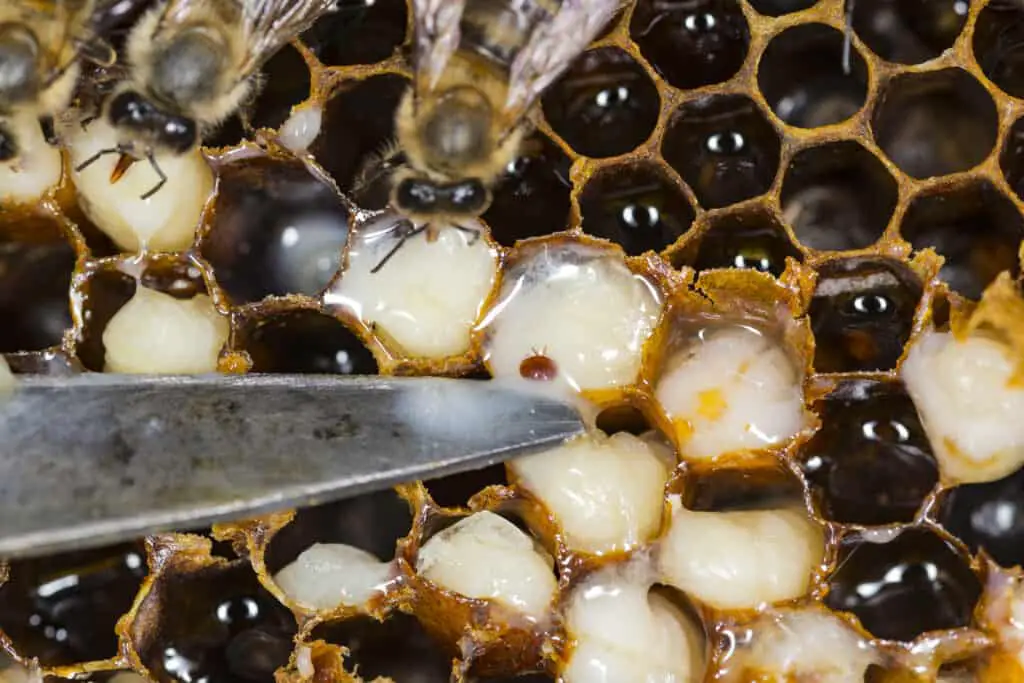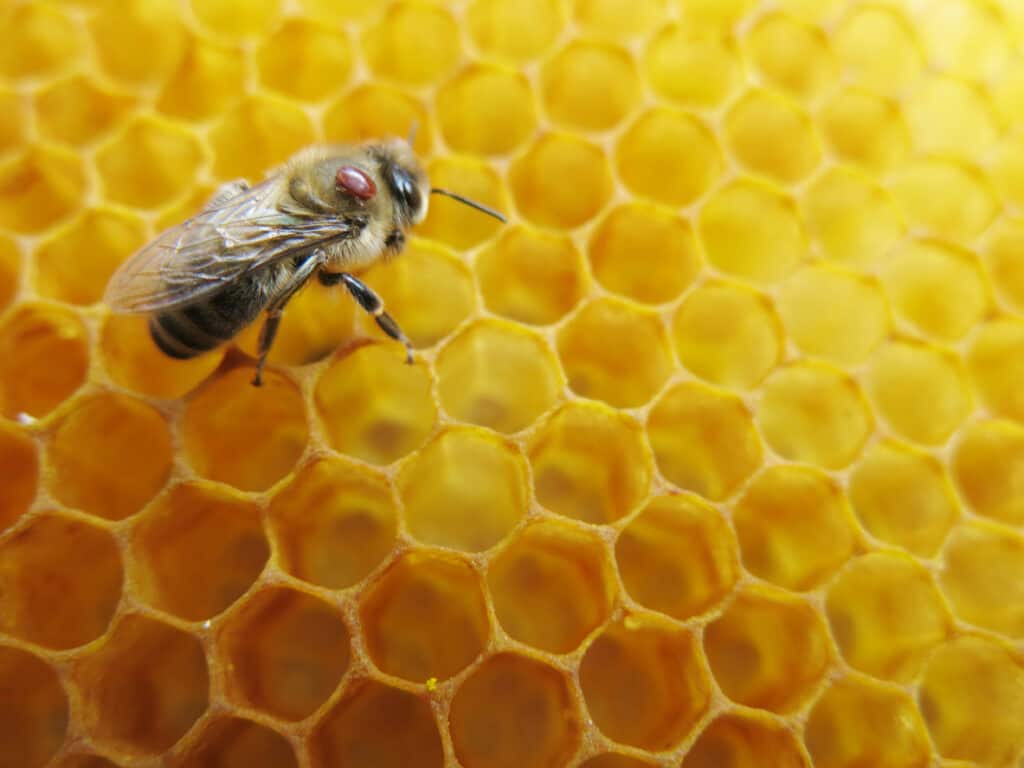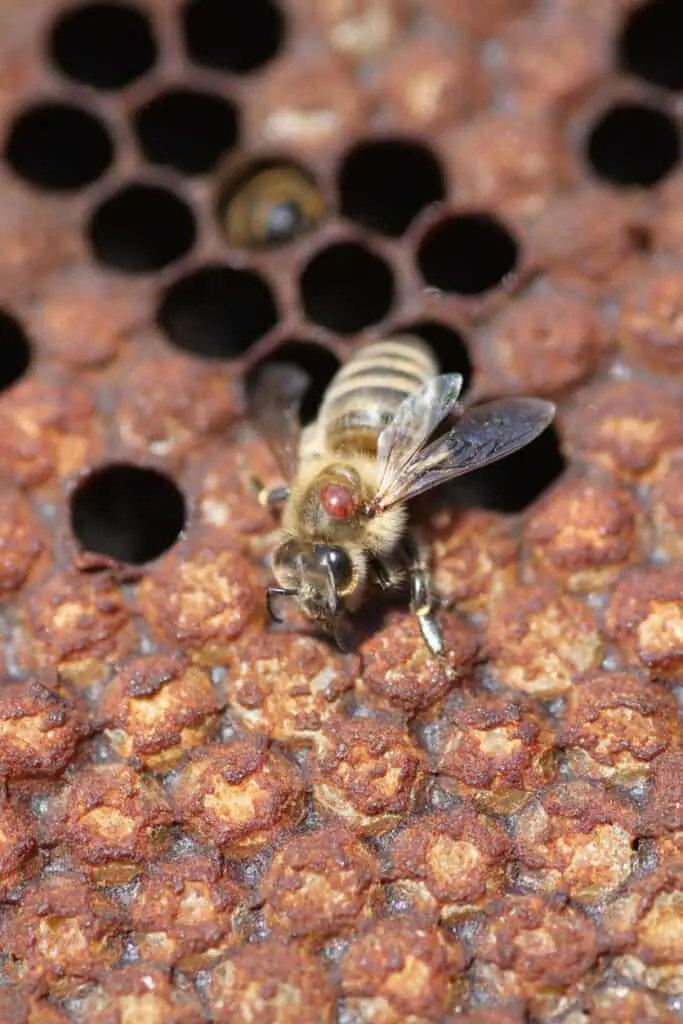Nothing is free of diseases or pests, and every living thing has a pest that causes havoc in its environment. Honey bees are not exempt from this unfortunate condition. Beekeepers will experience several issues that will confirm the presence of parasitic mites in their colonies.
There are several options available when treating bees for mites, from prevention methods to intervention treatments. Treating bees with natural chemicals like thymol, formic acid, oxalic acid, and hop beta acid can reduce the number of parasitic mites.
Treating bees for mites can be a bit of a tricky situation. I mean, how can you see a bug on a bug. But some signs will lead to the discovery of parasitic mites on your bees and the hive. Treating bees for mites should be part of your colony management, and knowing when, where, and how are important to keeping your hives strong and healthy for a longer period.
How To Treat Bees For Mites

Treating bees for mites is an important part of bee management. Mites can have a devastating outcome on the condition and health of your bees and the hive as a whole.
Knowing when to treat and how to treat mites is also essential as mites can easily reach out of control if left unattended.
What You Should Know About Bee Mites
There are several types of mites that will affect bees. Some are no threat to the bees, but some can be destructive to the hive and the lives of the bees.
There are currently two parasitic mites known to the US, tracheal mite and Varroa destructor. Another mite that is potentially dangerous to bees is the tropilaelaps mite native to Asia, but the institute of Animal Plant Health Inspection Service (APHIS) is keeping a close eye on this parasite in the US in case of any contamination from imported stocks.
Let’s stick to the mites that negatively affect the bees and how to deal with them.
1. Tracheal Mite

The tracheal mite is a microscopic throat mite that lives inside the honey bee respiratory system. This type of mite affects the adult bees such as worker bees, drone bees, and queen bees. As the name suggests, this mite lives and breeds inside the bees breathing tubes (tracheae) and feeds on the bee’s blood.
This infection affects the honey bee’s capacity to breathe, which opens the throat to pathogens that can greatly affect the airflow capacity of the wing muscles. This weakens the bee and reduces the work capacity that it can handle, and will also reduce the bee’s lifespan.
If a colony is infected with this parasite, it will remain infested. Winter and early spring can have the hardest influence and, in some severe cases, mean high colony losses.
Viable prevention for the spread of this infestation is using oil extender patties. These patties are made with 1 part liquid vegetable oil and three parts granulated or powdered sugar. Once the bees eat the sugar, they get coated with the oil, preventing the mites’ transfer between adult bees. This treatment is used in early spring and then again in the fall.
Treatments using organic chemicals containing thymol gel or formic acid are also widely used to control the infestation of tracheal mites.
2. Tropilaelaps Mite
Tropilaelap mites are native to Asia and infest the giant honey bee. Although this mite is native to Asia, it can infest the honey bee anywhere. These are external parasitic mites that feed on the blood of adult drones and worker bees. They will also infect broods and larva while they transform into adult bees.
Tropilaelaps mite that feeds on pupae can deform the emerging adult bee with stunted growth, damaged wings, and deformities. These mites can have a devastating effect on the hive as the spread can magnify in a matter of weeks.
This mite has not been reported in the United States.
3. Varroa Destructor

Varroa Mites are minute little red-brown parasites, the size of a pinhead that resembles a tick. External parasites attach themselves to the adult drone and worker bees and feed on the insect’s fat bodies (hemocoel).
The mite was native to Asia before it entered the United States in 1987. This mite is the lead cause of at least five known viruses seen on honey bees today.
The female varroa mites also lay their eggs in the larva cells of honey, where their young will feed on the developing pupae.
The varroa mites can reproduce at an alarming rate, and infestation of a colony can go from mild to out of control within weeks. This mite is possibly the one parasitic infestation with an economic impact on the beekeeping industry.
How Long Do Varroa Mites Live?
As the varroa mites can only reproduce in bee brood, the infestation is mainly found inside the hive of honey bees.
Since only the adult female varroa mites can feed on honey bees, they will attach themselves to bees that have robbed hives of declining bees infested with this mite. They may also hitchhike on other pollinators a wait for a bee to pollinate a flower before hitchhiking back with the bee to the hive.
Varroa mites affect the brood cells of drones and worker bees, but since drone brood cycles are larger and the post capping stages are longer (15 days for drones versus 11 days for worker bees), varroa mites prefer to lay eggs in the drone cells. The preference ratio of drone brood to worker bee brood is 9:1.
Female Varroa mites will enter the bee brood cell and lay 2-5 eggs after the cell is capped. The first egg laid will be male, and then the eggs are female.
After hatching, the varroa larva goes through 2 stages before developing into adults. The male takes 5-6 days, while the female takes 7-8 days to develop into an adult.
The male varroa will mate with the females inside the cell and die shortly after. Once the bees start to emerge from their cells, the daughter and mother team on varroa mites will emerge simultaneously, some will latch onto the young bee, and some will remain in the cell to attach themselves to other bees and repeat the process.
After two weeks of emerging from their birth cell, daughter varroa will lay eggs in the bee brood. A female varroa mite can live up to two months. However, it is possible for varroa mites to overwinter between the hardened plates of the bee’s exoskeleton.
What Viruses Do Varroa Mites Transmit To Bees?
Apart from being a pesky parasite that feeds off our important honey bees, these parasitic mites can also transfer several viruses to the colony (varroosis). If any or all of the three most common and noticeable viruses are detected in the hive, then there is a high level of infection in the colony.
Chewed Down Brood (CDB)
Bees will sense mites in the brood if the infested numbers become too high. They will uncap the brood and cannibalize the pupae. Due to the high levels and damage that the mites can have on the young bees, it is important to monitor your colony closely.
Deformed Wing Virus (DWV)
DWV is the next stage of varroosis. Bees with deformed wing viruses, especially drone bees, will be kicked out of the colony.
Parasitic Mite Syndrome (PMS)
This brood disease is similar to other diseases such as American foulbrood (AFB), European foulbrood (EFB), and Sacbrood virus. But unlike foulbrood disease, the larva does not rope out and does not smell.
Larvae may have a hollow or slumped appearance and lay at the bottom or to the side of the cell, which has been suggested that it is a sign of starvation.
Crawling and crippled bees are also signs of high mite levels, and an unexplained decrease in the colony’s numbers should be dealt with immediate treatment to avoid further hive decline and spread of the mites.
How Do I Protect My Hive Against Bee Mites?
Protecting your beehive colony is something that you will need to manage during the year. Having an integrated pest management system will help you control the number of varroa mites that infest your bee colony.
There are different approaches that one can use to control and reduce the spread of varroa mites. Using a combination of preventive and intervention methods may help your colony thrive even during the hardest times when mites are at their peak.
1. Cultural approach
The cultural approach is a preventive method used to help reduce the mites population. This method uses no chemical, and its efficacy is dependent on the effectiveness and possibility of the process.
- Resistant Stock-there is importers that have developed mite-resistant bees. This bee has been in contact with varroa mites for long periods and has developed traits that help control the number of mites on the bee and in the colony. Such an example is the Varroa-sensitive hygiene bees. These bees can recognize and remove the mite by removing infested brood and also increased grooming to remove mites from adult bees.
- Small cell comb-modernization of the beekeeping industry has made our jobs faster and that of the honey bee as well by the production of commercial foundation with hexagons that are 5.4mm in size instead of the bee’s natural comb of 4.9mm. Since research has shown that mite numbers decrease in the smaller cells, this method can potentially reduce mite populations.
- Brood break can significantly reduce the numbers in a colony and, in conjunction with a chemical treatment, can positively reduce the varroa mites. This method is accomplished by removing or caging the queen from the hive for approximately three weeks. During this time, the brood will hatch, and all the adult varroa mites will be forced to latch onto adult bees. The lack of brood will give the bees a break from their daily routine and increase grooming behavior, coupled with a mechanical approach of a screened bottom board will decrease the varroa mite drastically.
2. Mechanical Approach
This method is an effective way of controlling the population of varroa mites via the manipulation of the hive.
- Mite Trapping-since varroa mites are attracted to drone cells due to the size of the cell and the mite’s ability to reproduce six-folds compared to that of the worker bee cells. Adding drone combs to a colony will encourage drone production, acting as a trap for the mites. Once the cells are capped, remove that comb to remove the reproducing Varroa mites, this will effectively reduce the mite population. However, this may not be effective enough, and a combination method may be more beneficial.
- Screened bottom board-due to bees’ movement and grooming, the mites will naturally fall off. Using a screened board rather than a solid board at the bottom of the hive decreases the mite infestation of the brood cells. When the mites fall off, they will fall through the screen and are less likely to climb back into the box and onto the bees. Again this method is best used in conjunction with other methods for optimal efficacy.
- The powdered sugar-this approach can serve as a double effect. Sprinkling the bees with powdered sugar will increase their grooming tendencies. This is also a great way of doing mite counts on the colony. However, this should be done on bees removed from the hive equipment.
3. Chemical Approach
As varroa mites live for two months, they can easily reproduce from spring through to summer and, when left unchecked, will have devastating effects on the population number of the bees heading into winter.
Using a chemical miticide before the production of winter bees that will look after the brood and hive can positively control the numbers of the varroa mites for when the larvae emerge in the spring.
Soft chemicals should always be used where possible before using hard chemicals as these can harm the bees.
Soft Chemicals are naturally derived and are effective in treatments without leaving chemical residues on the hive, product, or bees.
- Formic acid-this acid is naturally found in the venom of bees and is a natural element of honey. This chemical, used at high concentrations, can penetrate the wax caps on the brood and kill reproducing mites. Unfortunately, it is temperature-dependent and, if used in temperatures over 85°F, will harm the colony and increase the brood’s death rate.
- Oxalic acid-this acid is naturally found in green leafy plants such as kale, spinach, beet, and rhubarb. This acid does not penetrate wax caps and is better suited to treating hives during periods when there is no brood or as a treatment for the winter bees. Overusing this acid or using it in high dosages can harm bees and the larvae.
- Thymol is an essential oil distilled from thyme plants. As it does not penetrate the wax capping, it does little to control mites in the brood cells. However, this essential oil is an effective way.
- Hops beta acids– these are the potassium salts derived from the hops plant and are safe to use. Although its efficacy is not as high as other soft chemicals, it is safe to use without any repercussions. More effective as a mite control on adult bees as this will not penetrate the wax caps in brood cells.
Hard chemicals are still legal but can leave residues in the bee products, making them less desirable for market use. Using hard chemicals like miticides is effective in about 95% of controlling varroa mites. They can also directly harm the bees and leave them susceptible to other diseases. These should only be used as a last resort.
- Amitraz- a popular synthetic acaricide in the control of varroa mites. Unfortunately, mites can form a resistance to this product and should not be used as a common approach to controlling mites. As with more hard chemicals, this can increase the deaths in the bee colony.
How To Do A Mite Count
There are several ways to check the percentage of mite infestation in your colonies. Some are more effective than others, although some have severe disadvantages. Weighing up the pros and cons will help you determine which method you are happiest to use.
| Method/Approach | Advantages | Disadvantages |
| Powdered sugar rolls method | Known research on the accuracyCommon methodMay not kill beesInvasive to bees | Messy to doIt needs many tools to performtricky to do on windy, rainy, or humid daystime-consumingLess accurateIt needs to be repeated to determine the accuracy |
| Alcohol or soap wash method | Well documentedfaster than powdered sugar rollsit is more accurate than a powdered sugar roll | Can be messyKills all beesRequires more than one test to determine the accuracy |
| Sticky board method | Quickest methodEasy to do with multiple coloniesNon-invasiveDifficult to determine the ratio | It needs to be done and checked weekly to get a trend pattern. |
The recommended amount of bees is a ratio of 3:100, so three mites per 100 bees tested for a well-controlled mite infestation.
How Often Should I Check Bees For Mites?
Checking for mites is an important part of bee management. If mites are left unchecked, they can multiply to uncontrollable numbers within four weeks.
It is recommended to check the hives at least three times a year in spring, summer, and fall. The likelihood that your colony is infested with varroa mites is high, and the question is how badly they are infested.
To control any possible outbreak of varroa mite infestation, maybe a better solution is to check the hives every month during bee season and increase your monitoring in late summer (July), when the risk is highest.
Although it is not always possible to check all the apiary in your yard, the general rule is to check at least 10% of your colonies. As a beginner beekeeper with a small number of colonies, it is best to check all the hives. If you have ten or fewer apiaries, you should check all of them.
A few ways to check your colonies for infestations are:
- Visually inspecting the hives and bees
- Uncapping drone brood cells
- Using a sticky board
- Alcohol or soap wash
- Powdered sugar roll
How Often Should I Treat For Mites?
Beekeeping requires constant beehive management, and treating your bees of mites depends on your bees’ genetics, location, time of year, and the products you use.
But on the whole, most beekeepers like to have finished their treatment cycle by the 17th of August to ensure the winter bees looking after the brood and hive during the long winter months are healthy enough to endure the cold winter.
A treatment again in dead winter is a good option as that is when there is little capped brood in the hive and mites can be properly controlled. Also, this down period for bees is the perfect time to administer a mechanical and soft chemical approach as this will increase bee grooming that helps remove mites on the adult bees.
What Are Mite Tolerant Bees?
When varroa mite entered the country and infested the honey bee, no one was prepared for the devastating results this little pest could cause and was the reason for hive declines. Our bees were not prepared genetically, as are the varroa mites natural host the Asian Giant bee, to deal with this infestation.
So, genetically resistant bees were developed, and the Varroa Sensitive Hygiene (VHS) bee was bred to fight the infestation of varroa mites. These bees exhibit traits to help control the population of mites in bees and brood cells.
As the word hygiene in their name suggests, these bees are particular about hygiene and tend to develop very high grooming ethics, which helps eliminate mites in the colony. They are also well adapted to sensing mites in brood cells. Once they sense this threat, they will uncap the cell, pull out any infested brood, and discard it to prevent mites from maturing.
Researchers believe that this trait is triggered by the odor the pupae give off once the mites feed on them.
So, the next time you are looking online for a new queen, find a supplier that advertises mite tolerant bees.
Mite tolerant bees do not mean the end of your mite problems, and any bee, tolerant or not, can collapse if the infestation is uncontrolled. Working together with your VHS will help manage your mite problems and help keep them under control.
Conclusion
Mites can be a very big problem for beekeepers and pose a total loss of colonies if not kept under control. Bee management is an important aspect of controlling the infestation, and a good treatment should be administered to the hive in August as this is when the mites can reach extremely dangerous numbers and cause the decline of your bees in the winter periods.
Method of treatment is also vital for controlling the mites, the health of your bees, and the product itself. Using hard chemicals can kill your stock and render your honey products unusable for market purposes.
References
- https://www.awe.gov.au/biosecurity-trade/pests-diseases-weeds/plant/bees
- https://www.science.org/content/article/breeders-toughen-bees-resist-deadly-mites
- https://www.honeybeesuite.com/august-is-a-critical-time-mite-management/ee-yard/
- https://extension.psu.edu/methods-to-control-varroa-mites-an-integrated-pest-management-approach
- https://pollinators.msu.edu/resources/beekeepers/varroa-mite-monitoring1/
- https://beeinformed.org/2015/03/20/know-your-honey-bee-colonies-non-destructive-testing-for-varroa-mites/
- https://extension.entm.purdue.edu/publications/E-201/E-201.html
- https://www.extension.iastate.edu/smallfarms/managing-varroa-mites-honey-bee-colonies
- https://www.dummies.com/article/home-auto-hobbies/hobby-farming/beekeeping/how-to-control-a-varroa-mite-problem-in-your-beehive-188383/
- https://bee-health.extension.org/varroa-mite-reproductive-biology/
- https://en.wikipedia.org/wiki/Varroa_destructor
- https://beeinformed.org/2018/09/26/the-signs-of-mite-damage-how-to-identify-progressed-varroosis/
- A comparative evaluation of sampling methods for Varroa destructor (Acari: Varroidae) population estimation (archives-ouvertes.fr)

